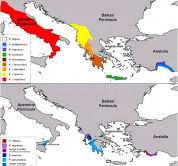
The Aegean region and neighboring territories attract the attention of scientists for the study of phylogeographical patterns of land animals, because of their turbulent geological history. The research focuses on the evolution and the historical dispersal routes of model groups of bush-crickets from the tribe Barbitistini. Their high diversity and complex behavior in the dynamic conditions of the Carpathian, Balkan and Asia Minor regions make their evolution comparable to the speciation in Galapagos (Darwin's) finches.
As a result of the project, a significant amount of new knowledge has been accumulated about the phylogeographic processes dominating the fauna in Southeast Europe and Southwest Asia during the Neogene and the Quaternary. The systematics of species groups of the genus Poecilimon - P. ampliatus, P jonicus, P. ornatus, as well as of the subgenus Hamatopoecilimon, distributed on the islands of the Aegean Sea, have been revised applying an integrative approach, including morphological, bio-acoustic and molecular methods. The origin, evolutionary strategies, and dispersal routes of the representatives of the genus Poecilimon, which includes more than 150 species, are studied. New bioacoustics data for representatives of the genera Poecilimon, Isophya, Uromenus have been accumulated and analyzed.
During the project, new and already existing international scientific collaborations were strengthened. Two young scientists were introduced to molecular and molecular phylogenetic studies. The results were summarized and published in 9 scientific articles and presented at 4 international scientific forums.
- Institute of Biodiversity and Ecosystem Research
Contact person: Dragan Chobanov, dchobanov@gmail.com
Borissov, S. B., Bobeva, A., Çıplak, B., & Chobanov, D. (2020). Evolution of Poecilimon jonicus group (Orthoptera: Tettigoniidae): a history linked to the Aegean Neogene paleogeography. Organisms Diversity & Evolution, 20(4), 803-819.
Borissov, S. B., Hristov, G. H., & Chobanov, D. P. (2021). Phylogeography of the Poecilimon ampliatus species group (Orthoptera: Tettigoniidae) in the context of the Pleistocene glacial cycles and the origin of the only thelytokous parthenogenetic phaneropterine bush-cricket. Arthropod Systematics & Phylogeny, 79, 401-418.
Chobanov, D. P., Sevgili, H., & Heller, K. G. (2020). Bioacoustics of poorly known Poecilimon taxa (Insecta: Orthoptera: Tettigoniidae) with redescriptions of P. pechevi and P. stschelkanovzevi. Zootaxa, 4890(4), 535-553.
Heller, K. G., Puskás, G. R., Nyi, G. S., & Chobanov, D. P. (2021). Songs in the genus Uromenus (Orthoptera: Tettigoniidae: Ephippigerini): A review with new information about some species. Zootaxa, 4991(1), 93-115.
Kaya, S., Chobanov, D., Heller, K. G., Yahyaoğlu, Ö., Uluar, O., & Çıplak, B. (2018). Review of Poecilimon species with inflated pronotum: description of four new taxa within an acoustically diverse group. Zootaxa, 4462(4), 451-482.
Kociński, M., Grzywacz, B., Hristov, G., & Chobanov, D. (2021). A taxonomic outline of the Poecilimon affinis complex (Orthoptera) using the geometric morphometric approach. PeerJ, 9, e12668.
Borissov, S. B., & Chobanov, D. P. (2020). Mitochondrial phylogeny of the subgenus Hamatopoecilimon Heller, 2011. Articulata, 35, 61-73.
Ivković, S., Chobanov, D., Horvat, L., Iorgu, I. Ș., & Hochkirch, A. (2022). Geographic differentiation in male calling song of Isophya modestior (Orthoptera, Tettigoniidae, Phaneropterinae). ZooKeys, 1122, 107.
Kociński, M., Chobanov, D., & Grzywacz, B. (2022). New insights into the genetic diversity of the Balkan bush-crickets of the Poecilimon ornatus group (Orthoptera: Tettigoniidae). Arthropod Systematics & Phylogeny, 80, 243-259.